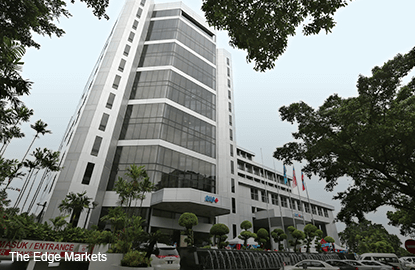
This article first appeared in The Edge Malaysia Weekly, on March 14 - 18, 2016.
 The cost of funds for banks — currently at a multi-year high — is expected to remain elevated moving forward, say bankers and analysts. This is despite the recent cut in the statutory reserve requirement by the central bank on Feb 1 to 3.5%, from 4%.
The cost of funds for banks — currently at a multi-year high — is expected to remain elevated moving forward, say bankers and analysts. This is despite the recent cut in the statutory reserve requirement by the central bank on Feb 1 to 3.5%, from 4%.
Banking analysts say the cost of funds for a number of banks has been on an uptrend, and for some, it may be higher than what it was during the 2008 global financial crisis. This, they say, is due to a number of factors such as shrinking liquidity and stricter regulatory demands amid a tougher operating landscape.
“For example, based on my calculations, the average cost of funds for Public Bank jumped to 2.38% in 2015 compared with an average of 2.1% in 2008. It was 2.18% in 2013 and 2.25% in 2014. For RHB Bank, its average cost of funds was about 2.27% in 2015 compared with 2.2% in 2014,” notes a banking analyst with a foreign research house.
While the three-month Klibor (Kuala Lumpur Interbank Offered Rates) has come off a high of 3.9% on Dec 8, banks are expected to incur higher funding cost moving forward. The three-month Klibor was at 3.79% on Jan 25, compared with 3.67% in June 2015.
The intensifying competition for deposits is another factor that will continue to drive up the banks’ cost of funds, say banking analysts.
Deposits are the cheapest form of funding for banks after borrowings and equity and the average cost of deposit rose to 2.53% as at Dec 31, 2015, compared with 2.38% in 2014.
However, growth of this funding pool is moderating. Deposit growth in the system only rose 0.9% year on year in January 2015. Month on month, total deposits shrank to RM1.658 trillion as at Jan 31, 2016, compared with RM1.67 trillion in December 2015.
The fight for retail deposits has intensified recently, not only because of shrinking liquidity in the system, but also because of the net stable funding ratio (NSFR) requirement that will come into effect in a few years. In addition, banks also have to adhere to a minimum liquidity coverage ratio (LCR) of 70% now, and 100% from January 2019.
Although the NSFR has not come into effect yet, banks have started preparing for it as it is part of a Basel III requirement. The NSFR limits over-reliance on short-term wholesale funding and encourages better assessment of funding risk across on- as well as off-balance sheet items.
“Banks are observing the ratio now in preparation for it coming into effect in 2017/2018. This is one of the reasons why they are competing for retail deposits. Under the NSFR, retail and SME deposits are categorised as stable,” says a banker.
“NSFR looks at the expected outflow of funds for the upcoming 30 days and if the bank has enough funds to cover for that outflow. The expected outflow of funds is not just deposits that are maturing but also the loans that will be disbursed,” she notes.
Interestingly, a large portion of retail savings is not classified as retail deposits in Malaysia.
“Local banks are wrongly penalised on the liquidity front. Malaysians put in over 20% of their salary into the Employees Provident Fund (EPF) and that is categorised as institutional deposits — the deposits are institutionalised through EPF,” explains an analyst with a foreign research house.
According to statistics on Bank Negara’s website, deposits by individuals make up over 35% of the total deposits in the system compared with Australia’s 40%.
Banks began competing for deposits as far back as 2012 as their loan-to-deposit (LD) ratios started creeping up. A high LD ratio shows a diminishing source of funding avenue for loan growth from deposits. The LD ratio of the system stood at 88.7% as at Dec 31, 2015.
Bank Negara recently introduced two new liquidity metrics — loan-to-fund ratio and loan-to-fund-and-equity ratio. These are alternatives to the LD ratio and the new metrics parameters include debt instruments, shares, retained earnings plus deposits. As at end-2015, the loan-to-fund ratio stood at 82.9% while the loan-to-fund-and-equity ratio was 74.5%.
While the two new ratios are lower than the LD ratio, indicating that there is liquidity in the system, banking analysts maintain that deposits remain the cheapest alternative of funding for banks. As such, the competition for deposits is expected to continue driving the cost of funds up and net interest margins (NIM) down.
Kenanga Research in a March 8 report notes that NIMs were compressed in 4Q2015, due to higher average cost of funds for the quarter.
“Average cost of funds increased by 8.5 basis points (3Q: -3bps q-o-q), whilst average lending yield increased by 3.5bps (3Q: +7.1bps). We believe this is due to banks shoring up their deposits. We believe banks will continue to shore up their deposits, thus competition for deposits will likely continue exerting downward pressure on NIMs,” it says.
It is worth noting that banks are offering rates as high as 4.5% per annum for fixed deposits and 2.75% for current and saving accounts.
Save by subscribing to us for your print and/or digital copy.
P/S: The Edge is also available on Apple's AppStore and Androids' Google Play.